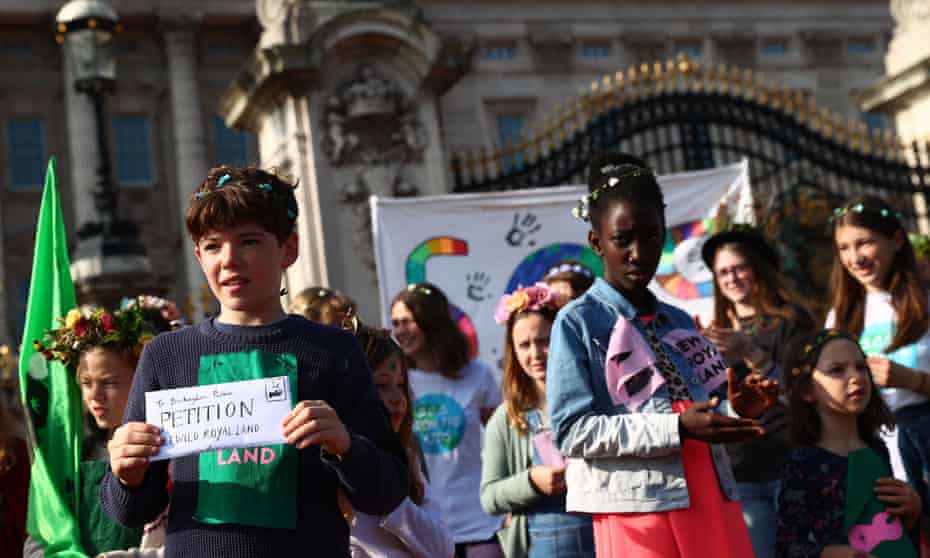What can the royals offer Cop26? A pledge to rewild their vast estates

Young people look at the monarchy and its sterile acres and see a huge opportunity to help cool the heating planet

Last weekend I saw a manifestation of hate and a vision of hope. It’s a couple of days I’ll never forget.
In the dark hours of Friday morning, masked thugs crept up to the gates in front of my home and firebombed a car in the driveway, presumably in an attempt to deliver a threatening message. After years of dead birds, badgers and foxes left hanging or thrown outside my house by people in favour of animal hunting, this latest action was a serious escalation. Whatever they wanted, whether they were members of a hunt or just internet trolls, it was clear that intimidation was their intention. As I watched the flames raging in the darkness, I admit I wondered where this would end.
Sleepless hours later I saw a very different image of our future. On Saturday morning I marched through a sunny Green Park in London with hundreds of children and families, to a rather grander set of gates, those of Buckingham Palace. Outside, with song and dance and flags, we called for the royal family to rewild their vast estates and bring wildlife back to our land. No threats or violence here. Instead a jazz band, papier-mache animals, fabulous hats and that most democratic and polite of protest actions: a petition, this one organised by campaign groups Wild Card and 38 Degrees and signed by more than 100,000 people. With one young protester actually admitted through the gates to deliver the petition, there was hope, not fear, in the air.
The difference could not have been more stark, and I’m just glad for the royals that their gates came off better than mine.
But this sharp contrast deserves consideration. Because these events represent two very different versions of the future of our landscape and very different ideas about how to achieve it. On the streets of London last Saturday I was privileged to meet young people who, even after being utterly failed by my generation, are somehow still optimistic that change might save them. On the track outside my house, I suspect I saw people who were filled with anger that such change was coming and that their age of assault on the living world may finally be over.
On the eve of the crucial Cop26 summit in Glasgow, at which members of the British monarchy are due to appear, the royals with their estates will find themselves forced to pick a side in this historic battle. The astonishing 1.4% of the country the royals own (that’s an area of land twice the size of Greater London) define some of the most nature-depleted landscapes in the world. In their more than 345,000 hectares (850,000 acres), huge areas of grouse moor and deer-stalking estates are, in the name of sport, kept artificially barren where exquisite temperate rainforest could and should grow. Grouse moors in particular – considered by experts to be ecological disaster zones – are regularly and deliberately burned. By annihilating the vegetation (and just about everything else that lives there), grouse moor defenders claim to be conserving historic landscapes while actually only preserving a colonial-era attitude to our precious natural world.
Elsewhere, royal land further undermines the environmental leadership that some royals have sincerely attempted. For all his love of tree planting, Prince Charles’s Duchy of Cornwall sadly has just 6% tree coverage compared with the EU average of 38%. No amount of cheese and wine-powered Aston Martins can fix that one. Meanwhile the Queen’s Sandringham estate, campaigners estimate, has barely 12% of its 20,000 acres set aside for priority habitats according to estimates by campaign group Who Owns Norfolk?. With Prince William recently taking to the BBC to champion rewilding, one wonders if the royals are actually aware of the current state of their own land – although pictures of William out hunting with his son do continue to jar with me. I do so wish we could meet and address these issues.
Thankfully, today’s young generation suffer no such delusions, and with their hope comes a piercing wisdom. They look at the nature-depleted landscapes of the royal estates and other big landowners and see an enormous opportunity to help cool their heating planet. They see a country in which 50% of our land is owned by less than 1% of the population and they see a glaring injustice with clear links to the environmental crisis. And when presented with the awe-inspiring thought that the Queen’s own estates could naturally feature beavers, golden eagles, bison and lynx, this generation doesn’t hesitate for a second: “Bring them back!” they shout. It’s a no brainer.
So as the royal family prepares to take to the world stage in Glasgow next month, I only hope that they carry those young people’s ambitious hopes with them. Making a commitment to rewilding on royal land before Cop26 would signal that their hope is not hollow. Restoring those 850,000 acres to nature would boldly say to the world that where rainforests have been destroyed, it can regrow, where species have vanished, they can return, and where flames of anger burn, progress can still win out.
-
Chris Packham is a naturalist, nature photographer and author, and a presenter on BBC Two’s Springwatch
